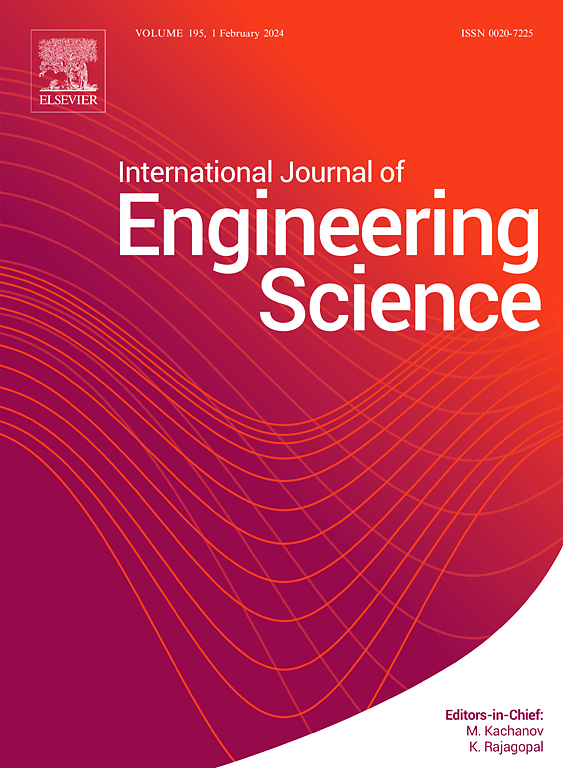多分支多段介电弹性体致动器的设计与控制及仿生应用
IF 5.7
1区 工程技术
Q1 ENGINEERING, MULTIDISCIPLINARY
International Journal of Engineering Science
Pub Date : 2025-04-12
DOI:10.1016/j.ijengsci.2025.104271
引用次数: 0
摘要
基于介电弹性体最小能量结构(DEMES)的介电弹性体致动器(dea)具有优异的动态形状变形和快速响应特性,在柔性致动器、智能夹持器和仿生装置中有着广泛的应用。虽然现有研究已经探索了DEMES的基本机制,但大多数研究都集中在简单的结构类型或单一的应用场景上。然而,设计、建模和计算通用、复杂dea的系统方法仍未得到充分探索。在这项工作中,基于Hamilton原理推导了电弹性悬臂板的非线性运动方程,以捕捉dea的非线性行为。设计了多结构单段dea,以研究驱动形状和框架几何构型对执行器性能的影响。此外,详细分析了四分支单段和六分支dea的复杂变形和抓取策略,考虑了每个分支的单个分支和部分的驱动。一种受章鱼启发的变刚度DEA设计用于使用不同的电压控制策略来抓取不同大小和形状的多边形物体。通过独立控制人手DEA的每个部分和手指来模仿不同的手势。通过旋转关节实验和微卫星夹持器的对比,验证了三段式和六段式关节夹持器的精度。此外,还提出了一种使旋转关节的扑动角变化与实际飞行条件密切匹配的占空比电压策略。结果证实了多分支多段dea在复杂任务中的独立性和可控性。本研究为推进柔性作动器领域提供了新的见解和方法,突出了dea在多任务和多目标操作中的巨大应用潜力。本文章由计算机程序翻译,如有差异,请以英文原文为准。
Design and control of multi-branch and multi-segment-based dielectric elastomer actuator and biomimetic applications
Dielectric elastomer actuators (DEAs) based on the dielectric elastomer minimum energy structure (DEMES) exhibit excellent dynamic shape deformation and fast response characteristics, making them widely applicable in flexible actuators, smart grippers, and biomimetic devices. While existing studies have explored the fundamental mechanisms of DEMES, most focus on simple structural types or single application scenarios. However, a systematic approach for designing, modeling, and computing versatile, complex DEAs remains underexplored. In this work, the nonlinear motion equations for an electroelastic cantilever plate are derived based on Hamilton's principle to capture the nonlinear behavior of DEAs. Multi-structured single-segment DEAs are designed to investigate the influence of the driven shape and geometric configuration of the frame on actuator performance. Additionally, complex deformations and grasping strategies for four-branch single-segment and six-segment DEAs are analyzed in detail, considering the actuation of individual branches and parts of each segment. An octopus-inspired variable-stiffness DEA is designed to grasp polygonal objects of varying sizes and shapes using diverse voltage control strategies. Different hand gestures are mimicked by independently controlling each segment and finger of a human hand-based DEA. The accuracy of the three-segment and six-segment DEMES is validated by comparison with rotary joint experiments and a microsatellite gripper, respectively. Additionally, a duty cycle voltage strategy that enables the variation of the flapping angle of a rotary joint to closely match real flight conditions is proposed. The results confirm the independence and controllability of multi-branch and multi-segment DEAs in complex tasks. This research offers new insights and methodologies to advance the field of flexible actuators, highlighting the vast application potential of DEAs in multi-task and multi-objective operations.
求助全文
通过发布文献求助,成功后即可免费获取论文全文。
去求助
来源期刊

International Journal of Engineering Science
工程技术-工程:综合
CiteScore
11.80
自引率
16.70%
发文量
86
审稿时长
45 days
期刊介绍:
The International Journal of Engineering Science is not limited to a specific aspect of science and engineering but is instead devoted to a wide range of subfields in the engineering sciences. While it encourages a broad spectrum of contribution in the engineering sciences, its core interest lies in issues concerning material modeling and response. Articles of interdisciplinary nature are particularly welcome.
The primary goal of the new editors is to maintain high quality of publications. There will be a commitment to expediting the time taken for the publication of the papers. The articles that are sent for reviews will have names of the authors deleted with a view towards enhancing the objectivity and fairness of the review process.
Articles that are devoted to the purely mathematical aspects without a discussion of the physical implications of the results or the consideration of specific examples are discouraged. Articles concerning material science should not be limited merely to a description and recording of observations but should contain theoretical or quantitative discussion of the results.
 求助内容:
求助内容: 应助结果提醒方式:
应助结果提醒方式:


